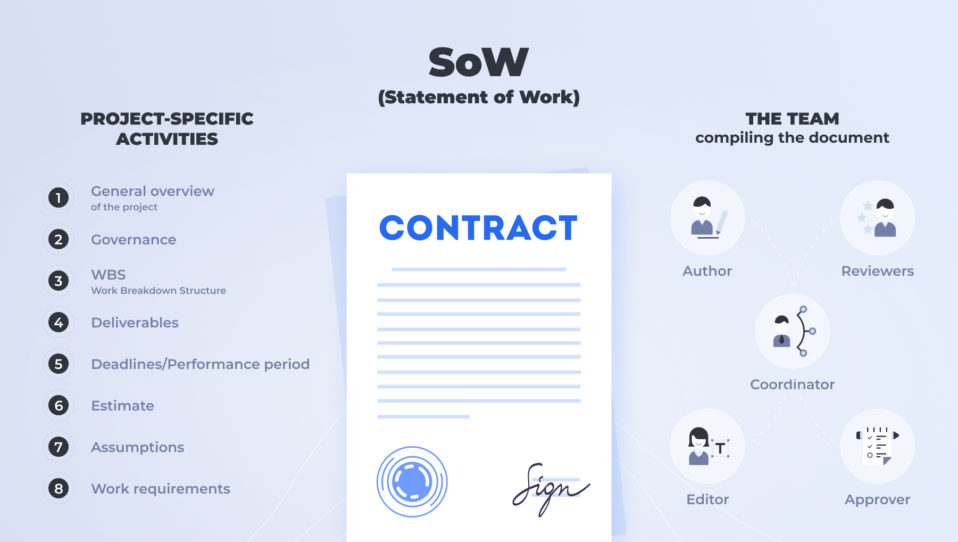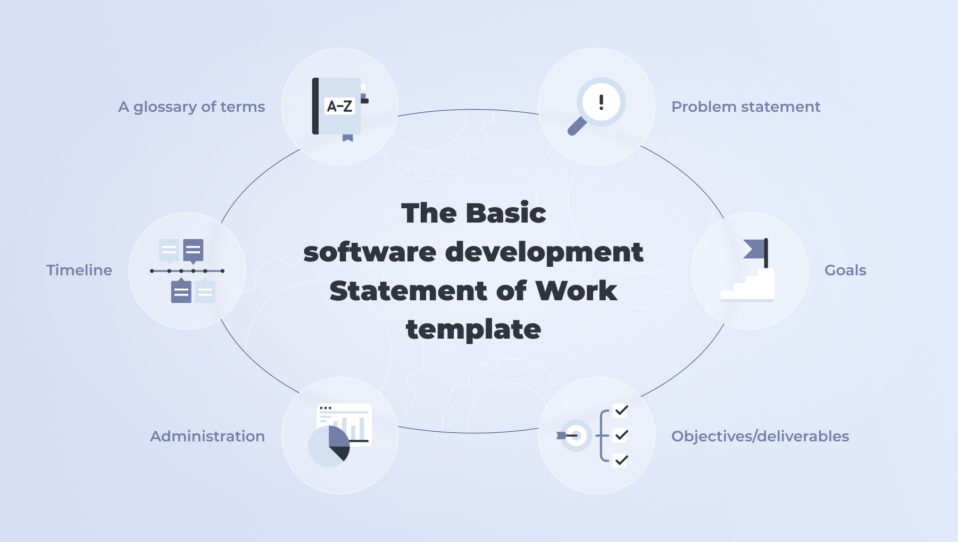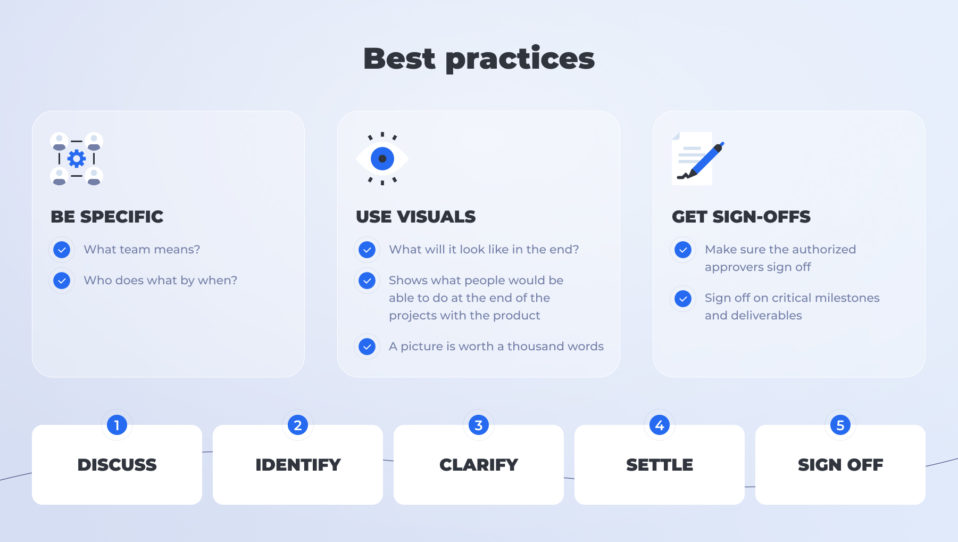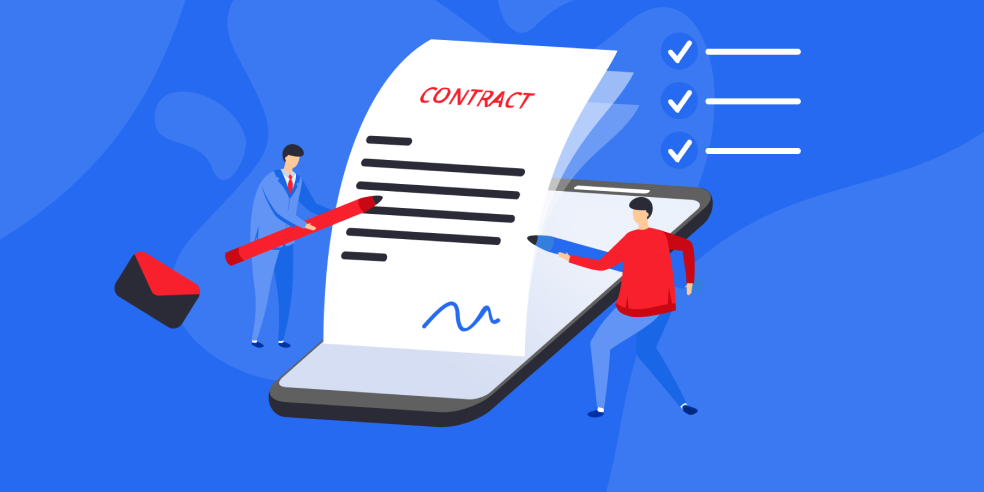Table of Contents
Every large system should work smoothly, but they only do in case all processes are perfectly attuned. The same applies to software development projects, where many people are involved and tens of processes are launched simultaneously.
Hence the need to elaborate on ideas and go further by forming a distinctive and detailed plan. This formalized plan is meant to enable both sides to have access to the transparent list of conditions and account of all the key issues to be tackled; all of the above is described and registered in a single document – called the SoW document.
It is the first document exchanged between the company and a client – an instrument that assists in settling all the ambiguous issues and resolves any possible misunderstandings between the parties involved. So, in essence, what is a software development statement of work? And does it make the lives of the client and vendor easier? Let us dive deeper into the topic and settle on the key characteristics of statements of work for software implementation.
Write a professional SoW Software contract
Productive partnerships are impossible without the validation of methodology, objectives, deadlines, payment, responsibilities, and requirements between the parties. The Software Statement of Work captures and defines these points and lays the groundwork for the project plan. As a baseline, the SoW document should consist of the following clarification points:
- General overview of the project – the essence of the project and the final expected result to be achieved
- Governance – the party responsible for the approval of the flow and outcome of the solution
- Work Breakdown Structure (WBS) – Comprises info on how the project will be delivered, what approach is taken as a basis, how it will be split (phases), and the lists of the specific tasks
- Deliverables – the final product that will be produced
- Deadlines/Performance period – the start and delivery dates, the list of milestones with time limits identification
- Estimate – information about the cost of the project and schedule of payments
- Assumptions
- Work requirements – approaches, tools and work requirements
The SoW document covers every critical point of the project, being a reference both for the client and the delivering company. Let us dive deeper and settle on the purpose of the document, its scope, the details of compilation and other related issues. Here you can download the example of SoW:
Purpose of The Statement of Work
After the green light and the word “go” from the client to the outsourcing partner, there arises the need to settle on the key issues and make sure they are understood by each party. The list of items where consensus is needed includes – methodology, deadlines, objectives, payment, responsibilities and requirements.
The software Statement of Work is essential since it provides the extra layer of substantiation for cost estimates logic. This level of detail provides reassurance to the client and serves as an instrument to enhance the cooperation and minimize the possibility of conflict, thus being a medium and a reference in case of conflict or confusion between the developers and client. It fleshes out all the minor details of the project, increases the quality of communication, and saves time and resources.
Ultimately, the SoW document serves as a reference point, since it comprises the budget details, and defines what features should be included in the cost of the project and what is outside of the budget. Thus, the clarity of this document is of extra importance since the failure to compile a detailed software development Statement of Work is all to often the reason for uncertainty, ambiguity, confusion or even sometimes conflict between the development company and client.
The notion of the Statement of Work is often confused with the Scope of Work, Master Service Agreement, Project Charter or Request for Proposals. See the table below to get a better understanding:
| Definition | Contains | |
| The Statement of Work | The project contract that has to align with expectations and set a precedent for development. Defines the scope and the working agreements between two parties.
| Provides high-level overarching project information and defines detailed deliverables, standards, criteria, and requirements for each phase. |
| Scope of Work | An agreement on the work you’re going to perform on the project. | Scope of Work in project management includes deliverables, a timeline, milestones and reports. |
| Master Service Agreement | A contract reached between parties, in which the parties agree to most of the terms that will govern future transactions or future agreements. | Specifies generic terms such as payment terms, product warranties, intellectual property ownership, dispute resolution, and liabilities. |
| Project Charter or Request for Proposals | A business document that announces a project, describes it, and solicits bids from qualified contractors to complete it. | The requests include a statement of work describing the tasks to be performed by the winning bidder and the timeline for finishing the work. |
Who is responsible for the compilation of the SoW document?
As is often the case, the Statement of Work is compiled by the outsourcing vendor who has the best possible understanding of all stages and details concerning the project. The compilation of an effective SoW document is only possible in case the author of the future document understands all the specificity of the project. Such an approach guarantees that the statement of work will be approved and followed. Usually, the document is created between a client and parties such as agencies or contractors that provide services. The possibilities of who can compile the document could be quite broad, this includes:
- Coordinator, who plans the content of the document and its parts
- Author, it can be one author or several of them, and they create the draft of the future document
- Reviewers are responsible for reviewing the SOW draft, commenting on it and offering changes.
- Editor, who curates the work of Reviewers by analyzing their comments and incorporating the offered changes for the delivery of the final draft
- Approver: this person approves and signs the SOW document.
The authors of SoWs mostly go off of ready-made custom templates, enabling them to comprise a comprehensive and in-depth document.

SOW Structure – nothing to overlook
As you may already assume, the SoW document writing process is time-consuming and demands a scrupulous approach. However, the more detailed the document is, the less the chance that ambiguity or uncertainty will arise. It also boosts project efficiency and customer delight. The structure and content of the documents may vary from project to project, however, for the most part, companies adhere to proven guidelines. Thus, the content is split into the following paragraphs:
Project Outline – it identifies the objectives of the project, describes participants. It is highly recommended including info about the date and location of drafting the SoW to avoid concerns about credibility and legitimacy. It also contains relevant project background info.
Purpose – the current section comprises details about the objectives a client wants to accomplish. It includes the outline why the project may be interesting, useful and contributive. Here it is also necessary to add the info describing what are the deliverables, and client’s predicted return on investment.
Scope of work and description – presents one of the most comprehensive parts of the entire document and demands considerable dedication. In this section, one should split the project delivery process into separate phases. The next planning step is splitting the phases into particular and comprehensive tasks – task breakdown, work breakdown or work breakdown structure (WBS). It helps to avoid the dreaded scope creep.
Here is the checklist with the key info points to be included:
- General budget overview
- The list of tasks and deliverables
- Personal tasks
- Phases of certain tasks
- The list of key specialists taking part in the project’s delivery, as well as their individual responsibilities
- Mentioning of people who will approve and accept the ready product
- Issues in functionality implementation and all the possible conditions that may influence the project
- All the specifications and limitations
- The list of requirements for Developers, QA, etc.
Operations location – As is often the case, the outsourcing vendor develops the product located overseas from the client’s country of origin since it opens wide opportunities for hiring cheaper gifted talent. However, inconveniences may arise due to factors such as time difference, different jurisdictions, cultures and language barriers. Moreover, if the client wants to conduct in-person meetings with vendor representatives, this is among the things that should be discussed and settled prior to the start of formal cooperation.
Timeline – A timeline that drafts a schedule outlining deliverables, milestones, project objectives, due dates, and project deadlines.
Financial details – Budgeting, financial details and payment terms, should include contract mode and payment model. It can either be a fixed-price model, suitable for contracts, where all the details are clearly identified. Or it can be floating, based on costs of inputs. Whereas the dedicated development model (where the client is in charge of specialists and putting them to work as they see fit) – is suitable for long-term projects, since it is more flexible and accommodating to rapid changes during development.
Acceptance criteria – Necessary as a reference for project approval, thus the project should clearly define success and failure.
Communication criteria and expectations – Getting stakeholders onto the same wavelength and page is a core part of any project, including software development ones
Identification of specific tasks and technical conditions – Laying out the technical and business specifications and requirements
Settlement of the standards – coding languages, industry standards to stick to, jurisdiction regulations, details about the testing, list of accepted devices, screen resolutions, browsers, tools for communication etc.
Monitoring – settlement of performance reviews and vendor’s reports.
Miscellaneous – information about the owner of the code, final admin duties, security regulations, estimate-effort level, etc.

Contracting for Agile projects – a documentary challenge
The content of the SoW document depends mainly on the methodology the vendor is utilizing. The most widespread methodologies include the traditional waterfall methodologies and, increasingly, Agile methodologies like Scrum. The most standard software development contracts were elaborated mostly to reflect the sequential waterfall methodologies. Contracting for Agile methodologies remains a challenge, but not impossible to overcome given a scrupulous approach.
In the traditional Waterfall development model, the project is split into the sequence of phases. It begins with the detailed planning phase, including the analysis of the details of the project. Since all the details are specified and documented, follow the stages of designing, coding, testing and integration phases, finally leading to deployment of the finished product.
Waterfall methodology was quite sophisticated since it presented a well-defined, clear and structured approach. You define the design and requirement at the outset of the project and it saves time and resources in future. However, this model is not flexible enough for dynamic projects and the requirements of the customer become frozen, despite the fact that they may actually change significantly over time.
In the Agile model, the project is divided into a series of short development cycles.
At Altamira we utilize the Agile methodology since it is flexible and adaptive enough to deliver the product that fully meets the customer’s expectations. We use Agile methodology as a basis for the Mobile App and Web development processes. It is iterative and incremental and allows our experts to add and change Mobile App features along the way at any stage of product development. We steer efforts at maximizing the results for the customers through effective cooperation within the developers’ team. Frequent reviews help deliver solutions that fully meet the customer’s needs. Our team quickly adapts to changes.
There exists several effective methodologies, which fall under the banner of Agile, including Scrum – our most preferred method. At Altamira we understand that it is necessary to take unique decisions, react quickly, deny the old-fashioned methodologies and follow the latest methodologies to achieve modern, high-level results. Breaking up the process into fixed-duration sprints contributes to a quick start for coding. It makes possible frequent releases of potentially shippable feature sets. Thus, flexibility and regular inspections enable the delivery of the final product to be of the highest quality.
Since software development is an inherently unpredictable process, compilation of a standard documentation for Agile Scrum becomes quite challenging. It is necessary to highlight 3 key goals for any software development contract:
- defining the purpose of the project (i.e. what are the parties trying to do?);
- defining how the project is to be established and run
- defining what happens if the project goes wrong

Using SoW documentation definitely satisfies these points, since it comprises a detailed and flexible set of conditions and other detailed descriptions, whilst at the same time also being flexible enough and accommodating to amendments. The goal of software Statement of Work is to present a list of the following requirements:
Backlog Product:
- Functional Requirements, translated into Epics and User stories
- Initial application design and implementation
- System Configuration to support business processes
- Integration for input and output methods
- Workflow design and implementation
- Overall collaboration of Apps
- Enhancements, patches and updates to Apps, clutches or data systems
- Data import of records collected from legacy systems
- Automated testing
- Training of end-users on the systems
Deliverables:
- Create base lining effort (Define to mutually agreed spring capacity)
- The vendor should develop, test, stage, and release business applications applying agile iterative processes and frequent release cycle
- Specified dates of deliverables
- Location and schedule of the kick-off meetings
Acceptance:
- How to determine?
- Who will review?
- Provide writing approval before the next sprint
- Warranty period for each sprint and phase
End of the Line
Compilation of software Statement of Work is a key factor securing the success of any project, since it forms the foundation for contractual expectations. SoW document comprises all the necessary information securing effective and pleasant partnership. Software development Statement of Work is a confirmation, clarifying that the company knows about the business goals and expectations of the client. Moreover, it is a guarantee of successful cooperation and productive partnership and carries legal gravity as well.



